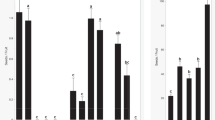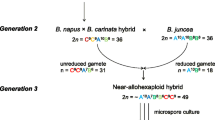Summary
A triploid hybrid (2n=3x=36) between a colchicine-induced 4x(2EBN) Solanum brevidens (a non-tuber-bearing species) and 2x(2EBN) S. chacoense (a tuber-bearing species) was used as a vehicle for germplasm transfer to S. tuberosum Group Tuberosum. The use of 2n gametes from the triploid allowed the unique opportunity for transferring exotic germplasm from Series Etuberosa to Gp. Tuberosum material. The triploid hybrid used had a pollen stainability of less than 0.1%. Observations of microsporogenesis revealed that metaphase I pairing configurations were primarily 12 bivalents and 12 univalents with occasional trivalents. Anaphase I separations were irregular, often with lagging univalents. Meiotic observations and pollen morphology suggest that the stainable pollen produced by the hybrid was 2n=3x=36. A single pentaploid hybrid (2n=5x=60) was produced by the fertilization of a rare 2n egg from the triploid with a normal male gamete from the clone ‘Wis AG 231’ (2n=4x=48). Limited crosses to other 1, 2 and 4EBN species and cultivars were unsuccessful. The pentaploid hybrid had a more regular meiosis than the triploid and dramatically improved pollen stainability (37% stainable pollen). Stylar blocks prevented estimates of male fertility in crosses. Female fertility in 47 crosses with nine cultivars averaged 19 seeds per fruit. Although S. brevidens is non-tuber-bearing, and the triploid produced only stolons, the pentaploid hybrid tuberized well under field conditions, despite being very late. Results suggest that the tuberization response is a dosage and/or threshold effect. This approach to the incorporation of 1EBN germplasm indicates the utility of the EBN concept coupled with 2n gametes. Further, it demonstrates a means for the introgression of 1EBN species genes into Gp. Tuberosum material.
Similar content being viewed by others
References
Hanneman Jr RE (1983) Assignment of Endosperm Balance Numbers (EBN) to the tuber-bearing Solanum species. Am Potato J 60:809–810 (Abstr)
Hawkes JG, Hjerting JP (1969) The potatoes of Argentina, Brazil, Paraguay and Uruguay. A biosystematic study. Ann Bot Mem 3:525 pp
Hermsen JG Th (1980) Recent progress and future plans for utilizing Mexican wild species for pest and disease resistance. In: Utilization of the genetic resources of the potato III. International Potato Center (CIP), Lima, Peru, pp 129–139
Hermsen JG Th, Ramanna MS, Sawor Z (1981) The effect of chromosome doubling on fertility, meiotic behavior and crossability of Solanum etuberosum x S. pinnatisectum. Euphytica 30:33–39
Hermsen JG Th, Taylor LM (1979) Successful hybridization of non-tuberous Solanum etuberosum Lind, and tuber-bearing S. pinnatisectum Dun. Euphytica 28:1–7
Johnston SA (1980) The role and nature of genie balance in endosperm development. PhD Thesis, University of Wisconsin-Madison, 157 pp
Johnston SA, den Nijs TPM, Peloquin SJ, Hanneman Jr RE (1980) The significance of genie balance to endosperm development in interspecific crosses. Theor Appl Genet 57:5–9
Johnston SA, Hanneman Jr RE (1982) Manipulations of Endosperm Balance Number overcome crossing barriers between diploid Solanum species. Science 217:446–448
Jones RAC (1979) Resistance to potato leaf roll virus in Solanum brevidens. Potato Res 22:149–152
Lin BY (1975) Parental effects on gene expression in maize endosperm development. PhD Thesis, University of Wisconsin-Madison, 190 pp
Marks GE (1965) Cytogenetic studies in tuberous Solanum species. 3. Species relationships in some South and Central American species. New Phytol 64:293–306
Pandey KK (1962) Interspecific incompatibility in Solanum species. Am J Bot 49:874–882
Peloquin SJ, Hougas RW (1959) Decapitation and genetic markers as related to haploidy in Solanum tuberosum. Eur Potato J 2:176–183
Ramanna MS, Hermsen JG Th (1979a) Unique meiotic behavior in F1 plants from a cross between a non-tuberous and a tuberous Solanum species in section Petota. Euphytica 28:9–15
Ramanna MS, Hermsen JG Th (1979b) Genome relationships in tuber-bearing Solanums. In: Hawkes JG, Lester RN, Skelding AD (eds) The biology and taxonomy of the Solanaceae. Academic Press, London New York, pp 647–654
Ramanna MS, Hermsen JG Th (1982) Gene transfer from nontuberous to tuberous Solanum species: evidence from meiosis in hybrids. Euphytica 31:565–572
Ross RW, Rowe PR (1965) Frost resistance among the Solanum species in the IR-1 potato collection. Am Potato J 42:177–185
Toxopeus HJ (1964) Treasure-digging for blight resistance in potatoes. Euphytica 13:206–222
Author information
Authors and Affiliations
Additional information
Communicated by H. F. Linskens
Rights and permissions
About this article
Cite this article
Ehlenfeldt, M.K., Hanneman, R.E. The use of Endosperm Balance Number and 2n gametes to transfer exotic germplasm in potato. Theoret. Appl. Genetics 68, 155–161 (1984). https://doi.org/10.1007/BF00252332
Received:
Accepted:
Issue Date:
DOI: https://doi.org/10.1007/BF00252332




